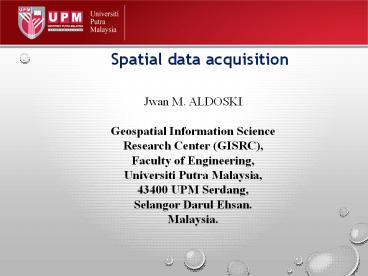Spatial Data acquisition PowerPoint PPT Presentation
Title: Spatial Data acquisition
1
Spatial data acquisition
Jwan M. ALDOSKI Geospatial Information Science
Research Center (GISRC), Faculty of Engineering,
Universiti Putra Malaysia, 43400 UPM Serdang,
Selangor Darul Ehsan. Malaysia.
2
Spatial data acquisition
- There are two methods for spatial data
acquisition - Primary methods Surveying, Photogrammetry,
GNSS and Remote Sensing - Secondary methods
- Digitization, Automatic line following, and
scanning
3
Surveying
- Surveying is a technique of mapping features
using different instruments. - Equipments include tape (short distance), level
(height), theodolite/total station (angle,
distance)
Digital level
Total station
4
Photogrammetry
- Photogrammetry is a technique of mapping features
using aerial photos - Photos (Black/white/color/infrared) are taken by
a set of cameras onboard an airplane. - Instruments that can be used to help in the
interpretation are stereoscope, stereo plotters
(deriving contours and Digital Elevation Model
DEM)
5
Example of aerial photo Kuala Lumpur
6
Global Navigation Satellite Systems (GNSS)
- GNSS are sets of satellites that send signal
which is received by users to determine (X,Y,Z)
of any point on the earth - Receivers vary in accuracy, size, and cost (e.g.
Trimble, Leica, Magellan, Garmin and Javad) - GPS, GLONASS, Galileo, QZSS, IRNSS, Beidou
7
Remote Sensing
- Remote sensing is a technique of mapping features
using Satellite imagery. Images (Black/white or
color-Multiple bands) are taken by a set of
sensors onboard a satellite - Features are mapped from satellite imagery using
visual interpretation or automatic classification - Example of remote sensing satellites are LANDSAT,
ERS-1,2, SPOT, JERS-1, RADARSAT
8
Space technology elements
9
The secondary data acquisition
- Designed to transfer data into the GIS from
secondary sources (image, reports, attribute and
map data) - Must be provided with means for spatial
referencing - Keyboard entry is a good example of secondary
data input - Input through keyboard is time consuming, but it
can be more accurate. It is suitable for small
areas i.e. when the number of points/lines/areas
are limited - Two other common ways are digitizing and scanning
10
Digitizing and scanning
- Digitization is a process of converting existing
maps to digital form (vector format) - When cross hair is moved over the screen its
location is known because the georeferencing of
map/images senses it location. - Scanning is a process of converting existing maps
to digital form (raster format) - A scanner is connected to a computer and map
features are scanned automatically - Scanners are available at different sizes (A4
till A0) and different accuracy (600 dpi, 1000
dpi etc)
11
Rasterization and vectorization
- Regardless of input device, it is necessary to
determine if the final product will be raster or
vector - Most GIS programs allow conversion between the
two, but problems are involved - If vector to raster, cell size is also important,
but the results are satisfactory - If raster to vector, lines become blocky and
step-like, cant reverse the procedure to produce
original content of vector line also, resolution
(or cell size) has a direct effect on the spatial
integrity of the object - Several algorithms can be applied as smoothing
function to vector lines
12
Thank you

